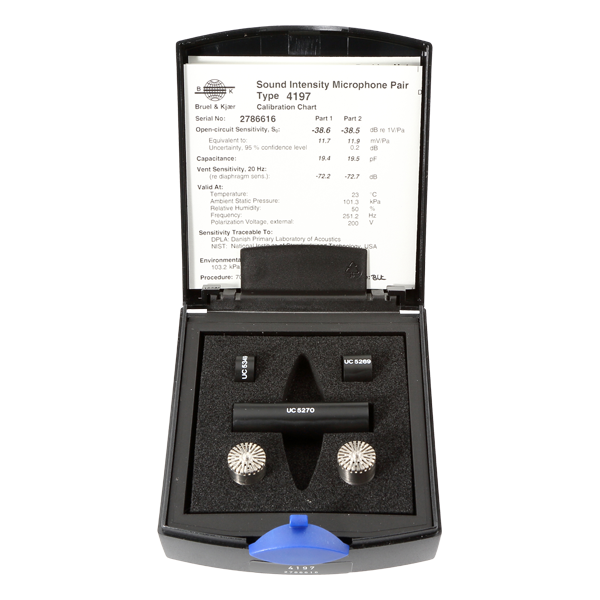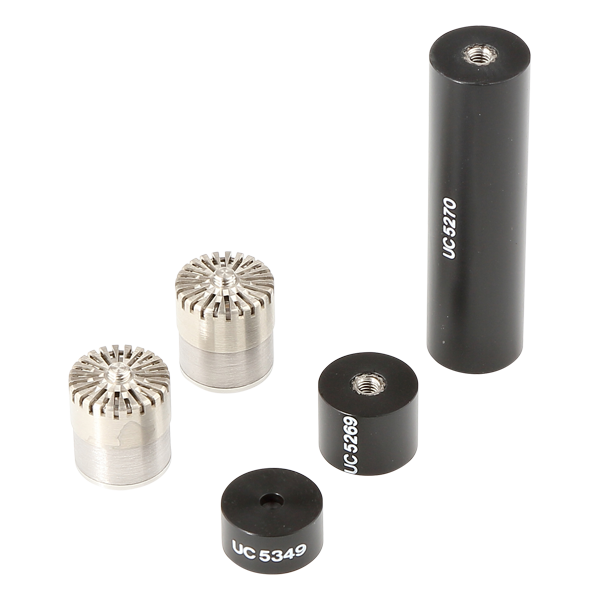TYPE 4197
½-inch Microphone pair for Sound Intensity
Phase-matched pair of ½-inch microphones, designed for being used with Brüel & Kjær’s range of sound intensity analyzers.
Solicitar ofertaType 4197 is a pair of ½ inch phase-matched microphones, designed to be used with Type 3599, a two-microphone probe kit for measuring sound intensity. Used with the ½-inch Microphone pair Type 4197, the probe complies with IEC 1043 Class 1. These 1/2-inch microphones feature patented phase-corrector units making precision low-frequency phase matching a practical possibility, leading to increased measurement range and accuracy.
USE SCENARIOS
- Sound intensity measurements with Brüel & Kjær's two-microphone probe kit Type 3599, using two-microphone technique, in accordance with IEC 1043 Class 1
- Sound power measurements with Brüel & Kjær's two-microphone probe kit Type 3599, in accordance with ISO 9614-1, ISO 9614-2, ECMA 160 and ANSI S 12-12
- Sound intensity mapping
MEASURING SOUND INTENSITY USING A TWO-MICROPHONE PROBE KIT
To measure sound intensity accurately using a two-microphone technique, you need a reliable sound intensity probe set containing a matched microphone pair to obtain information on both the instantaneous pressure and pressure gradient in the sound field. The microphones are separated by a fixed distance in the sound field, and the microphone signals are fed to a sound intensity processor which calculates the sound intensity. The sound intensity is calculated from the time average of the sound pressure multiplied by the particle velocity (calculated from the measured pressure gradient). Such a system measures the component of the sound intensity along the probe axis and also indicates the direction of energy flow.
PROBE DESCRIPTION
The sound intensity probe is constructed on a face-to-face design. It comprises a robust frame which holds the microphone preamplifier(s) and matched microphones in a face-to-face configuration. The distance between microphones is defined by solid, plastic spacers, held in place by threaded studs on the microphone grids. Sound is constrained to act on each microphone through a narrow slit between the spacer and the microphone grid. This gives well-defined acoustic separation of the microphones and minimises shadow and reflection effects.
The probe is strong but lightweight and can be connected directly to the remote control unit or a simple handle. To minimise the acoustical disturbance, an extension stem may be used between the handle/remote control unit and the probe. The probe kit is supplied in a carrying case containing a microphone pair, windscreen (ellipsoidal) and accessories. The case has pockets for the remote control unit handle, a Sound Level Calibrator Type 4231 and other small accessories.
SOUND INTENSITY MICROPHONE PAIRS
Phase matching of 1/2" Microphone Pair Type 4197 is better than 0.05° between 20 Hz and 250 Hz, and is better than f/5000 degrees at higher frequencies, where f is the frequency. Such phase matching is possible as a result of the integral microphone phase-corrector units (patented) which are fitted to the Type 4197 microphones. The normalised microphone frequency responses differ by less than 0.2 dB up to 1 kHz and by less than 0.4 dB up to 7.1 kHz.
Type 4197 is supplied with 8.5 mm, 12 mm and 50 mm spacers. Calibration data provided include phase matching up to a 1/3-octave centre frequency of 6.3 kHz, microphone sensitivities at 250 Hz, actuator responses and individual free-field frequency responses valid for the microphones mounted on a 1/4" preamplifier.
Brüel & Kjær can also supply a 1/4" Microphone Pair Type 4178 which consists of a pair of 1/4" microphones, phase matched to better than 0.2° from 20 Hz to 1 kHz and sensitivity matched to better than 1 dB. Type 4178 is supplied with 6 mm and 12 mm spacers, along with calibration charts giving the individually measured free-field frequency response for each microphone.
PATENTED MICROPHONE PHASE-CORRECTOR UNITS
The phase matching specified for the Type 4197 microphone pair is retained even in sound fields with very high pressure-level gradients, such as those found close to point sources. This is a benefit of the patented phase-corrector units which are fitted to these microphones. Ordinary condenser microphones can have their phase responses altered if there is a difference between the pressure level at the pressure equalisation vent and that at the diaphragm. Type 4197 microphones are, however, essentially insensitive to sound at the vent and the accuracy of near-field measurements at low frequencies is consequently increased.
CALIBRATION
Phase calibration of 1/2" Microphone Pair Type 4197 is done at Brüel & Kjær by subjecting the two microphones to the same sound signal in a pressure coupler. This individual phase calibration can be used to derive the actual Pressure-Residual Intensity Index for the microphone pair.
Complete calibration of sound intensity measurement systems containing a sound intensity probe set can be conveniently made using Sound Intensity Calibrator Type 3541. This permits simultaneous sensitivity adjustment of both channels of the processor (in both pressure, particle velocity or intensity modes) and allows determination of the Pressure-Residual Intensity Index of the probe and processor combinations which employ microphone pairs with phase-corrector units. The probe need not be dismantled to calibrate the microphones.
- Capacitance
- 19.5 pF
- Diameter
- ½
- Dyn. range
- 20 – 162 dB
- Freq. range
- 0.3 – 20000 Hz
- Inherent noise
- 20 dB A
- Lower limiting frequency -3dB
- 0.14 Hz
- Optimised
- Sound Intensity
- Polarization
- Ext polarized
- Polarization voltages
- 200 V
- Pressure coefficient
- -0.007 dB/kPa
- Sensitivity
- 11.2 mV/Pa
- Temperature coefficient
- -0.002 dB/ºC
- Temperature range
- -10 – 50 ℃
- Weight
- gram
- Input type
- Classic
- Microphone type
- Free field

Suscríbase a nuestro boletín informativo y recibirá las últimas noticias de B&K sobre sonido y vibración


